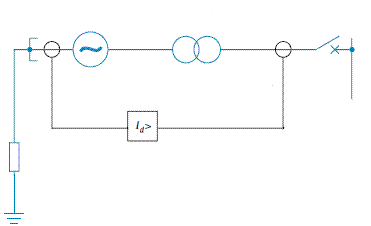We don’t eliminate 5th harmonic current in differential protection system, indeed we use it for stabilizing of differential protection against transformer transient overfluxing. Harmonic content of transformer excitation current is predominantly odd harmonic. Typical transformer excitation current will contain a fundamental component, which is 52% of nominal, a third harmonic component equal to 26% of nominal, a fifth harmonic component equal to 11% of nominal, a seventh harmonic component equal to 4% of nominal, and so on. Transformer differential relays are subjected to operation on high transformer excitation current. However, the operating characteristic of the relay on such current does not correlate well with transformer overexcitation limit characteristics. As such, it is not practical to use differential relaying as a means to protect transformers against overexcitation. On the downside, transformer differential relays are subject to operating on overexcitation current at levels below that which may cause damage to the transformer. Moreover, operation of differential relaying caused by overexcitation could cause confusion to post disturbance investigations. Larger transformers, for which overexcitation is a concern, should be equipped with dedicated overexcitation protection and associated differential relayi ng should be blocked from operating on excitation current. Therefore the application of 5th harmonic restrain in power transformers differential protection is subjected to overfluxing phenomenon which occurs when the ratio of voltage to frequency is too high. The iron saturates owing to the high flux density and results in stray flux occurring in components not designed to carry it. Overheating can then occur, resulting in damage. The problem affects both direct-and indirectly-connected generators. Either excessive voltage, or low frequency, or a combination of both can result in overfluxing, a voltage to frequency ratio in excess of 1.05p.u. normally being indicative of this condition.  Excessive flux can arise transiently, which is not a problem for the generator. For example, a generator can be subjected to a transiently high power frequency voltage, at nominal frequency, immediately after full load rejection. Since the condition would not be sustained, it only presents a problem for the stability of the transformer differential protection schemes applied at the power station.In such cases, consideration should be given to applying protection with transient overfluxing restraint/blocking e.g. based on a 5th harmonic differential current threshold. Also geomagnetic disturbances may result in overfluxing without the V/f threshold being exceeded. Some relays provide a 5th harmonic detection feature, which can be used to detect such a condition, as levels of this harmonic rise under overfluxing conditions.
Excessive flux can arise transiently, which is not a problem for the generator. For example, a generator can be subjected to a transiently high power frequency voltage, at nominal frequency, immediately after full load rejection. Since the condition would not be sustained, it only presents a problem for the stability of the transformer differential protection schemes applied at the power station.In such cases, consideration should be given to applying protection with transient overfluxing restraint/blocking e.g. based on a 5th harmonic differential current threshold. Also geomagnetic disturbances may result in overfluxing without the V/f threshold being exceeded. Some relays provide a 5th harmonic detection feature, which can be used to detect such a condition, as levels of this harmonic rise under overfluxing conditions.

 Excessive flux can arise transiently, which is not a problem for the generator. For example, a generator can be subjected to a transiently high power frequency voltage, at nominal frequency, immediately after full load rejection. Since the condition would not be sustained, it only presents a problem for the stability of the transformer differential protection schemes applied at the power station.In such cases, consideration should be given to applying protection with transient overfluxing restraint/blocking e.g. based on a 5th harmonic differential current threshold. Also geomagnetic disturbances may result in overfluxing without the V/f threshold being exceeded. Some relays provide a 5th harmonic detection feature, which can be used to detect such a condition, as levels of this harmonic rise under overfluxing conditions.
Excessive flux can arise transiently, which is not a problem for the generator. For example, a generator can be subjected to a transiently high power frequency voltage, at nominal frequency, immediately after full load rejection. Since the condition would not be sustained, it only presents a problem for the stability of the transformer differential protection schemes applied at the power station.In such cases, consideration should be given to applying protection with transient overfluxing restraint/blocking e.g. based on a 5th harmonic differential current threshold. Also geomagnetic disturbances may result in overfluxing without the V/f threshold being exceeded. Some relays provide a 5th harmonic detection feature, which can be used to detect such a condition, as levels of this harmonic rise under overfluxing conditions.